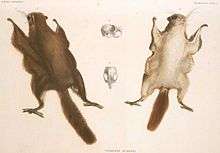Old World flying squirrel
Commonly referred to as the Old World flying squirrels, the genus Pteromys is distributed across temperate Eurasia, the Korean Peninsula and Japan. Although there are a host of flying squirrel genera in Asia (particularly southern Asia), Pteromys is the only one present in Europe.
| Old World flying squirrels Temporal range: Late Pliocene – Recent | |
|---|---|
 | |
| Japanese dwarf flying squirrel, (Pteromys momonga) | |
| Scientific classification | |
| Kingdom: | Animalia |
| Phylum: | Chordata |
| Class: | Mammalia |
| Order: | Rodentia |
| Family: | Sciuridae |
| Tribe: | Pteromyini |
| Genus: | Pteromys G. Cuvier, 1800 |
| Species | |
|
Pteromys volans | |
Characteristics
These large-eyed animals are nocturnal and use a membrane stretching from their wrists to ankles in order to glide from tree to tree. They can glide up to 443 feet (135 m) and have a long flat tail. They feed on nuts, seeds, fruit, buds, bark, and insects.
Species
There are two species in this genus:
- Pteromys volans – Siberian flying squirrel – Found in northern Europe (mainly Russia and Finland, some isolated populations in Estonia and Latvia) and northern Asia.
- Pteromys momonga – Japanese dwarf flying squirrel – Found in Japan (Honshu and Kyushu).
gollark: We're ready to initiate Contingency Sigma-74, you?
gollark: Greetings.
gollark: >pickup
gollark: >daily
gollark: <@160279332454006795> I did it. NONE are safe.
References
- Nowak, Ronald M. 1999. Walker's Mammals of the World, 6th edition. Johns Hopkins University Press, 1936 pp. ISBN 0-8018-5789-9
This article is issued from Wikipedia. The text is licensed under Creative Commons - Attribution - Sharealike. Additional terms may apply for the media files.


.jpg)